List of largest birds
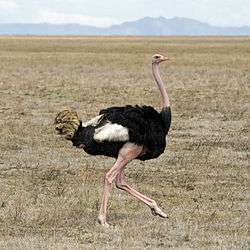
The largest living bird, a member of the Struthioniformes, is the ostrich (Struthio camelus), from the plains of Africa and Arabia. A large male ostrich can reach a height of 2.8 metres (9.2 feet) and weigh over 156 kilograms (344 pounds).[1] A mass of 200 kg (440 lb) has been cited for the ostrich but no wild ostriches of this massive weight have been verified.[2] Eggs laid by the ostrich can weigh 1.4 kg (3.1 lb) and are the largest eggs in the world today.
The largest living bird by wingspan is the Wandering Albatross (Diomedea exulans) of the sub-Antarctic oceans. The maximum dimensions in this species are a length of 1.44 m (4.7 ft) and a wingspan of 3.65 m (12.0 ft).
Largest birds ever
The largest bird in the fossil record may be the extinct elephant birds (Aepyornis) of Madagascar, which were related to the ostrich. They exceeded 3 m (9.8 ft) in height and 500 kg (1,100 lb).[3] The last of the elephant birds became extinct about 300 years ago. Of almost exactly the same upper proportions as the largest elephant birds was Dromornis stirtoni of Australia, part of a 26,000-year-old group called mihirungs of the family Dromornithidae.[4] The largest carnivorous bird was Brontornis, an extinct flightless bird from South America which reached a weight of 350 to 400 kg (770 to 880 lb) and a height of about 2.8 m (9 ft 2 in).[5] The tallest bird ever however was the giant moa (Dinornis maximus), part of the moa family of New Zealand that went extinct around 1500 CE. This particular species of moa stood up to 3.7 m (12 ft) tall,[1] but weighed about half as much as a large elephant bird or mihirung due to its comparatively slender frame.[3]
The heaviest bird ever capable of flight was Argentavis magnificens, the largest member of the now extinct family Teratornithidae, found in Miocene-aged fossil beds of Argentina, with a wingspan up to 5–6 m (16–20 ft), a length of up to 1.26 m (4.1 ft), a height on the ground of up to 1.5–2 m (4.9–6.6 ft) and a body weight of at least 71 kg (157 lb).[3][6] Rivaling Argentavis in wingspan if not in bulk and mass, another contender for the largest known flying bird ever is Pelagornis sandersi, which had a wingspan of up to 7.3 m (24 ft).[7]
Largest living birds
Table of heaviest living bird species
The following is a list of the heaviest living bird species based on maximum reported or reliable mass, but average weight is also given for comparison. These species are almost all flightless, which allows for these particular birds to have denser bones and heavier bodies. Flightless birds comprise less than 2% of all living bird species.
| Rank | Animal | Binomial Name | Average mass [kg (lb)] |
Maximum mass [kg (lb)] |
Average total length [cm (ft)] |
Flighted |
|---|---|---|---|---|---|---|
| 1 | Ostrich | Struthio camelus | 104 (230)[8] | 156.8 (346)[8] | 210 (6.9)[9] | No |
| 2 | Somali ostrich | Struthio molybdophanes | 90 (200)[8] | 130 (287) | 200 (6.6)[8] | No |
| 3 | Southern cassowary | Casuarius casuarius | 45 (99)[8] | 85 (190)[10] | 155 (5.1)[8] | No |
| 4 | Northern cassowary | Casuarius unappendiculatus | 44 (97)[8] | 75 (170)[8] | 149 (4.9)[9] | No |
| 5 | Emu | Dromaius novaehollandiae | 33 (73)[8][11] | 70 (150) | 153 (5)[8] | No |
| 6 | Emperor penguin | Aptenodytes forsteri | 31.5 (69)[9][12] | 46 (100)[9] | 114 (3.7)[9] | No |
| 7 | Greater rhea | Rhea americana | 23 (51)[11] | 40 (88)[9] | 134 (4.4)[8] | No |
| 8 | Domestic turkey/wild turkey | Meleagris gallopavo | 13.5 (29.8) [13] | 39 (86)[14] | 100 - 124.9 (3.3 – 4.1) | Yes |
| 9 | Dwarf cassowary | Casuarius bennetti | 19.7 (43)[8] | 34 (75)[8] | 105 (3.4) | No |
| 10 | Lesser rhea | Rhea pennata | 19.6 (43)[8] | 28.6 (63)[8] | 96 (3.2)[9] | No |
| 11 | Puna rhea | Rhea tarapacensis | 15 (33) | 25 (55) | 92 (3) | No |
| 12 | Mute swan | Cygnus olor | 11.87 (26.2) | 23 (51) | 100-130 (3.3-4.3)[15] | Yes |
| 13 | Great bustard | Otis tarda | 10.6 (23.4) | 21 (46)[3] | 115 (3.8) | Yes |
| 14 | King penguin | Aptenodytes patagonicus | 13.6 (30)[9][12] | 20 (44)[16] | 92 (3) | No |
| 14 | Kori bustard | Ardeotis kori | 11.4 (25.1)[9] | 20 (44.1) | 150 (5)[9] | Yes |
| 16 | Trumpeter swan | Cygnus buccinator | 11.6 (25.1) | 17.2 (38) | 138-165 | Yes |
| 17 | Arabian bustard | Ardeotis arabs | 10.9 (24) | 16.8 (37) | 108-150 | Yes |
| 18 | Wandering albatross | Diomedea exulans | 11.9 (24) | 16.1 (35)[17] | 107-135 | Yes |
| 19 | Whooper swan | Cygnus cygnus | 11.4 (25) | 15.5 (32) | 140-165 | Yes |
| 20 | Dalmatian Pelican | Pelecanus crispus | 11.5 (25) | 15 (33.1) | 183 (6) | Yes |
| 20 | Great white pelican | Pelecanus onocrotalus | 11 (24) | 15 (33.1) | 175 (5.8) | Yes |
| 20 | Japanese crane | Grus japonensis | 10.5 (23) | 15 (33.1) | 158 (5.3) | Yes |
| 20 | Siberian crane | Leucogeranus leucogeranus | 8.6 (19) | 15 (33.1) | 127 (4.2) | Yes |
| 24 | Andean condor | Vultur gryphus | 11.3 (25)[15] | 14.9 (33)[15] | 100-130 (3.3-4.3)[15] | Yes |
By families
- Birds of prey (Accipitriformes)
- The New World vultures are still generally considered a member of this order,[18] although the inclusion is dubious at best.[19] If they are included, the largest species in the order, if measured in regard to body weight and wingspan, is the Andean condor (Vultur gryphus) of western South America. The great bird can reach a wingspan of 3.2 m (10 ft)[1] and a weight of 15 kg (33 lb).[20]
- The largest extant species is the Eurasian black vulture (Aegypius monachus), attaining a maximum size of 14 kg (31 lb), 1.2 m (3.9 ft) long and 3.1 m (10 ft) across the wings.[21] Other vultures can be nearly as large, with the Himalayan vulture (Gyps himalayensis) reaching lengths up to 1.5 m (4.9 ft) thanks in part to its long neck.[22]
- The largest living eagle (the larger varieties of active-hunting raptors) is a source of contention, with the Philippine eagle (Pithecophaga jefferyi), at up to 1.12 m (3.7 ft), being the longest. The Steller's sea eagle (Haliaeetus pelagicus) of Asia's North Pacific, at unconfirmed weights of up to 12.7 kg (28 lb) and an average weight of 6.7 kg (15 lb), is regarded as the heaviest eagle. The harpy eagle (Harpia harpyja) of the neotropical forests is often cited as the largest eagle, as well, and captive females have weighed up to 12.3 kg (27 lb).[3] The white-tailed eagle (Haliaeetus albicilla) measures 66–94 cm (26–37 in) in length with a 1.78–2.45 m (5.8–8.0 ft) wingspan. The wingspan, with a midpoint of 2.18 m (7.2 ft), is on average the largest of any eagle. It is sometimes considered the fourth-largest eagle in the world and is on average the fourth-heaviest eagle in the world. The martial eagle (Polemaetus bellicosus) is the largest eagle in Africa and is the fifth-heaviest (on average) eagle in the world, with a length of 78–96 cm (31–38 in), weight of 3–6.2 kg (6.6–13.7 lb) and a wingspan of 188–260 cm (6 ft 2 in–8 ft 6 in). The longest-winged eagle ever was an Australian wedge-tailed eagle (Aquila audax) at 2.83 m (9.3 ft), though this species is not as heavy as the previous species. The golden eagle (Aquila chrysaetos) is barely smaller-winged, with the Himalayan subspecies recorded to 2.77 m (9.1 ft).[3] Less substantiated records indicate that the Steller's sea eagle may reach up to 2.74 m (9 ft),[23] potentially rivaling the two previous species. The harpy and Philippine eagles, due to having to navigate in deep forest, are relatively short-winged, and do not exceed 2 or 2.2 m (6.6 or 7.2 ft), respectively, in wingspan.[3] The now extinct Haast's eagle (Harpagornis moorei), which existed alongside early aboriginal people in New Zealand, was easily the largest eagle known and perhaps the largest raptor ever. Adult female Haast's were estimated to average up to 1.4 m (4.6 ft) long, a 15 kg (33 lb) body weight and a relatively short 3 m (9.8 ft) wingspan.[24]
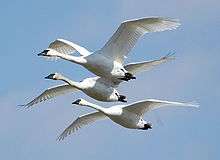
- Waterfowl (Anseriformes)
- The largest waterfowl species in average size is the trumpeter swan (Cygnus buccinator) of Northern North America, which can reach an overall length of 1.82 m (6.0 ft), a wingspan of 3.1 m (10 ft), and a weight of 17.3 kg (38 lb).[25] However, other species have greater individual variation. Thus the heaviest single waterfowl ever recorded was a cob mute swan (Cygnus olor) from Poland, which weighed 23 kg (51 lb) and was allegedly too heavy to take flight.[3]
- Swifts and allies (Apodiformes)
- The largest species are the white-naped swift (Streptoprocne semicollaris), endemic to southern Mexico, and the purple needletail (Hirundapus celebensis), of the Philippine islands. Both reach similar large sizes, at up to 225 g (7.9 oz), more than 0.6 m (2.0 ft) across the wings and 25 cm (9.8 in) in length.[26]
- The hummingbirds are also traditionally included in this order, the largest species of which is easily the giant hummingbird (Patagona gigas) of the Andes Mountains. "Giant" is a relative term among the hummingbirds, the smallest-bodied variety of birds, and this species weighs up to 24 g (0.85 oz) at a length of 23 cm (9.1 in).[27]
- The longest hummingbird species, indeed the longest in the order, is the adult male black-tailed trainbearer (Lesbia victoriae), which can measure up to 25.5 cm (10.0 in), but a majority of this length is due to the extreme tail streamers. Another size champion among hummingbirds is the sword-billed hummingbird, a fairly large species in which about half of its 21 cm (8.3 in) length is from its bill (easily the largest bill-to-body-size ratio of any bird).[28]
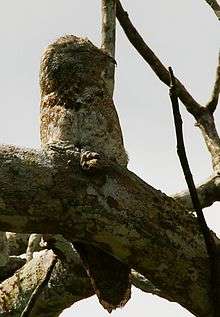
- Nightjars and allies (Caprimulgiformes)
- The largest species of this order of nocturnal, mysterious birds is the neotropical great potoo (Nycitbius grandis), the maximum size of which is about 680 g (1.50 lb) and 60 cm (2.0 ft). Heavier specimens have been recorded in the bulky Australian tawny frogmouth (Podargus strigoides) species, especially juvenile birds, which can weigh up to 1.4 kg (3.1 lb). Other species nearly as large as the potoo are the Papuan frogmouth (Podargus papuensis) of New Guinea and the neotropic, cave-dwelling oilbird (Steatornis caripensis), both at up to 48 cm (19 in).
- The largest species in the true nightjar family, the great eared nightjar (Eurostopodus macrotis) of East Asia, is rather smaller at up to 150 g (0.33 lb) and 41 cm (16 in).[29] The wingspan in the great potoo and the oilbird can be more than 1 m (3.3 ft), the largest of the order.[30][31]
- Shorebirds (Charadriiformes)
- The largest species in this diverse order is the great black-backed gull (Larus marinus) of the North Atlantic, attaining a size of as much as 0.79 m (2.6 ft), a wingspan of 1.7 m (5.6 ft) and weighing up to 2.3 kg (5.1 lb). The glaucous gull (L. hyperboreus) is, on average, somewhat smaller than the black-back but has been weighed at as much as 2.7 kg (6.0 lb).[11][32]
- Among the most prominent family of "small waders", the sandpipers reach their maximum size in the Far Eastern curlew (Numenius madagascariensis) at up to 0.66 and 1.1 m (2.2 and 3.6 ft) across the wings, although the more widespread Eurasian curlew (N. arquata) can weigh up to 1.36 kg (3.0 lb).[33][34]
- Less variable in size, the plovers largest species is the Australasian masked lapwing (Vanellus miles) at up to 0.4 m (1.3 ft) long, a 0.85 m (2.8 ft) wingspan and a weight of 400 g (14 oz).[35] The terns, previously considered members of the gull family, are usually slender and dainty-looking in comparisonm but the largest species, the widely distributed Caspian tern (Hydroprogne caspia), is quite large and heavily built. Caspians can range up to 782 g (1.724 lb), a 1.4 m (4.6 ft) wingspan and 0.6 m (2.0 ft) in length.[36][37]
- The largest extant alcid is the sub-Arctic thick-billed murre (Uria lomvia), which can range up to 1.48 kg (3.3 lb), a length of 0.48 m (1.6 ft) and a small wingspan of 0.76 m (2.5 ft).[38] However, until its extinction, the flightless great auk (Pinguinus impennis) of the North Atlantic, was both the largest alcid and the second largest member of the order. Great auks could range up to 6.8 kg (15 lb) and 0.9 m (3.0 ft) tall.[39]
- Miomancalla was the largest charadriiform of all time, weight about a pound-and-a-half more than the Great Auk and being about 1 m (3.3 ft) tall[40]
_female.jpg)
- Herons and allies (Ciconiiformes)
- The longest-bodied and tallest species in the order is probably the slender, towering saddle-billed stork of Africa (Ephippiorhynchus senegalensis), which often exceeds 1.5 m (4.9 ft) tall and has a wingspan of up to 2.7 m (8.9 ft).[41] Reaching a similar or slightly shorter height but more heavily built among the storks are the neotropical jabiru (Jabiru mycteria), the Asian greater adjutant (Leptoptilos dubius) and the African marabou stork (L. crumeniferus), all of which are believed to weigh up to 8 to 9 kg (18 to 20 lb). are either Oriental stork (Ciconia boyciana) 00–129 cm (0–51 in) long, 110–150 cm (43–59 in) tall, a weight of 2.8–5.9 kg (6.2–13.0 lb) and a wingspan of 2.22 m (7.3 ft).[11][42] The greater adjutant and marabou nearly equal the Andean condor in maximum wingspan. All three are believed to reach or exceed 3.16 m (10.4 ft) and are regarded as having the largest wingspan of any landbirds (that is species who live over land as opposed to tied to the sea or wetlands).[3] Standing up to 1.53 m (5.0 ft), with a wingspan of up to 2.3 m (7.5 ft) and a weight up to 5 kg (11 lb) is the African goliath heron (Ardea goliath), the largest of the diverse and well-known herons and egrets. The white-bellied heron (A. insignis) is generally smaller, but gigantic, unverified juveniles have been reported to 8.5 kg (19 lb) and 1.58 m (5.2 ft).[43]
- Many of the largest flying birds in the fossil record may have been members of the Ciconiiformes. The heaviest flying bird ever, Argentavis magnificens, is part of a group, the teratorns, that are considered an ally of the New World vultures.[44]
- The largest ibis is the giant ibis (Thaumatibis gigantea). Adults are reportedly 102–106 cm (40–42 in) long, with an upright standing height of up to 100 cm (39 in) and are estimated to weigh about 4.2 kg (9.3 lb). Among standard measurements, the wing chord is 52.3–57 cm (20.6–22.4 in), the tail is 30 cm (12 in), the tarsus is 11 cm (4.3 in) and the culmen is 20.8–23.4 cm (8.2–9.2 in). The adults have overall dark greyish-brown plumage with a naked, greyish head and upper neck. There are dark bands across the back of the head and shoulder area and the pale silvery-grey wing tips also have black crossbars. The beak is yellowish-brown, the legs are orange, and the eyes are dark red. Juveniles have short black feathers on the back of the head down to the neck, shorter bills and brown eyes. having this crested ibis (Nipponia nippon) of Japan is a large (up to 78.5 cm long), white-plumaged ibis of pine forests. Its head is partially bare, showing red skin, and it has a dense crest of white plumes on the nape. This species is the only member of the genus Nipponia.
- Mousebirds (Coliiformes)
- The mousebirds of Africa are remarkably uniform, but the largest species is seemingly the speckled mousebird (Colius striatus), at 2 ounces (57 g) and over 14 inches (36 cm).[45]

- Pigeons (Columbiformes)
- The largest species of the pigeon/dove complex is the Victoria crowned pigeon (Goura victoria) of Northern New Guinea, although the other crowned pigeons approach similar sizes. Some exceptionally large Victoria crowneds have reached 3.7 kg (8.2 lb) and 85 cm (33 in). The largest arboreal pigeon is the Marquesan imperial pigeon (Ducula galeata), which is up to about 0.8 m (2.6 ft) across the wings and can weigh 1 kg (2.2 lb).[46]
- The passenger pigeon (Ectopistes migratoritus) of North America. The average weight of these pigeons was 340–400 g (12–14 oz) and, per John James Audubon's account, length was 42 cm (17 in) in males and 38 cm (15 in) in females.[47]
- Some flightless birds found on islands off East Africa are the largest extinct pigeons and doves known to have existed: the dodo (Raphus cucullatus), which was physically somewhat like an outsized pigeon, and the Rodrigues solitaire (Pezophaps solitaria), a brown, long-necked bird that was superficially ratite-like. Both species may have exceeded 1 m (3.3 ft) in height. All were carelessly hunted it into extinction by humans and introduced animals. The dodo is most frequently cited as the largest-ever pigeon, as it could have weighed as much as 28 kg (62 lb), although recent estimates have indicated that an average wild dodo would have weighed around 10.2 kg (22 lb), scarcely larger than a male turkey.[48][49] If dodos were this light, the Rodrigues solitaire may have been larger. Some estimates claim the solitaire was merely swan-sized but others estimate weights of up to 27.8 kg (61 lb).[50][51]
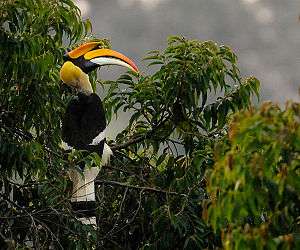
- Kingfishers and allies (Coraciiformes)
- The largest species is the southern ground hornbill (Bucorvus leadbeateri), reaching sizes of as much as 6.2 kg (14 lb) and 1.3 m (4.3 ft) in length.[52] Several arboreal, Asian hornbills can grow very large as well, with the great hornbill (Buceros bicornis) weighing to 4 kg (8.8 lb) and the helmeted hornbill (Rhinoplax vigil) measuring as much as 1.7 m (5.6 ft) in total length.[53][54] The larger hornbills have a wingspan of up to 1.83 m (6.0 ft).[55]
- The largest kingfisher overall is the giant kingfisher (Megaceryle maxima), at up to 48 cm (19 in) long and 425 g (15.0 oz), with a large crest and finely spotted white on black upperparts.[56] However, the common Australian species, the laughing kookaburra (Dacelo novaeguineae), may be heavier still, since individuals exceeding 450 g (0.99 lb) are not uncommon. A kookaburra wingspan can range up to 0.9 m (3.0 ft).[57]
- Cuckoos, coucals and roadrunners (Cuculiformes)
- The largest of the cuckoos is the Australasian channel-billed cuckoo (Scythrops novaehollandiae), which can range up to a weight of 0.93 kg (2.1 lb), a 1 m (3.3 ft) wingspan and a length of 0.66 m (2.2 ft).[58][59]
- Falcons (Falconiformes)
- Many authorities now support the split of falcons from the Accipitriformes, despite similar adaptations, due to the genetic evidence showing they are not closely related.[60] The largest species of falcon is the gyrfalcon (Falco rusticolus). Large females of this species can range up to 2.1 kg (4.6 lb), span 1.6 m (5.2 ft) across the wings and measure 0.66 m (2.2 ft) long.[21] The largest extinct Titanohierax was a giant hawk about 8 kilograms that lived in the Antilles, where it was among the top predators.
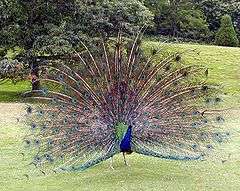
- Gamebirds (Galliformes)
- The heaviest member of this diverse order is the North American wild turkey (Meleagris gallopavo). The largest specimen ever recorded was shot in 2015, and weighed 17.05 kg (37.6 lb).[61] The heaviest domesticated turkey on record, a very obese bird, weighed 37 kg (82 lb).[1]
- The longest species, if measured from the tip of the bill to the end of the long tail coverts, is the male green peafowl (Pavo muticus) of Southeast Asia, at up to 3 m (9.8 ft) long. This is the longest overall length for any flying bird, although about two-thirds of the length is made up by the tail coverts, and this species (to 5 kg (11 lb)) weighs less than its cousin, the Indian peafowl (P. cristatus), at up to 6 kg (13 lb). Although, wingspan is relatively small in most galliformes, both larger peafowl species can span as much as 1.6 m (5.2 ft) across the wings.[62]
- The largest member of the grouse family is the Eurasian western capercaillie (Tetrao urogallus), at up to 6.7 kg (15 lb) and 1 m (3.3 ft). A prehistoric, flightless family, sometimes called (incorrectly) "giant megapodes" (Sylviornis) of New Caledonia were the most massive galliformes ever, up to 1.7 m (5.6 ft) long and weighing up to about 40 kg (88 lb).[63]
- The largest gamebirds is the domestic chicken (Gallus gallus domestica). The shanks and outer toes are slightly feathered. In the original birds the males topped 10 lb (4.5 kg); today cocks weigh 9.5 lbs/3.75–4.25 kg and hens 7.5 lb (3.4 kg). Hatching eggs should weigh at least 58 g.
- Loons (Gaviiformes)
- The largest species on average is the yellow-billed loon (Gavia adamsii) of the Arctic, at up to 1 m (3.3 ft) and 7 kg (15 lb). However, one exceptionally large North American common loon (Gavia immer), weighed 8 kg (18 lb), heavier than any recorded yellow-billed loon. Wingspan in these largest loons can reach 1.52 m (5.0 ft).[64]
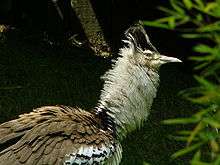
- Cranes and allies (Gruiformes)
- The males of the Eurasian great bustard (Otis tarda) and the African kori bustard (Ardeotis kori) are the heaviest birds capable of flight, averaging up to 16 kg (35 lb) and weighing 2 to 3 times as much as their female counterparts. It is not resolved if one of these species is larger than the other, but both can reach a weight of at least 21 kg (46 lb)[1] and measure up to 1.53 m (5.0 ft) long.[3][65] Some kori bustards have been reported from 23 kg (51 lb) to even 40 kg (88 lb), but all such reports are unverified or dubious.[66]
- The tallest flying bird on earth, also represented in the Gruiformes, is the sarus crane (Grus antigone) of Southern Asia and Australia, which can reach a height of 2 m (6.6 ft).[67] Heavier cranes are reported in other species, the red-crowned crane (Grus japonensis) and the Siberian crane (G. leucogeranus), both from Northeast Asia and both at up to 15 kg (33 lb), as opposed to a top weight of 12.8 kg (28 lb) in the sarus.[3][11][68] Wingspan in both the largest cranes and the largest bustards can range up to 2.5–3 m (8.2–9.8 ft).[69][70]
- The most species-rich family in this order, the rails, reaches their largest size in the bulky takahē (Porphyrio hochstetteri) of New Zealand, an endangered species that can weigh up to 4.2 kg (9.3 lb) and measure 0.65 m (2.1 ft) long.[71] The aforementioned "terror bird", Brontornis burmeisteri, has traditionally been classified as a member of this order, although this may not be an accurate classification.
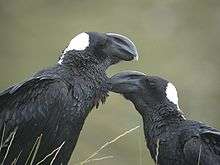
- Songbirds (Passeriformes)
- The passerine or songbird order comprises more than half of all bird species, and are known for their generally small size, their strong voices and their frequent perching. Corvids are the largest of passerines, particularly the large races of the common raven (Corvus corax) and the Northeast African thick-billed raven (C. crassirostris). Large ravens can weigh 2 kg (4.4 lb), attain a 1.5 m (4.9 ft) wingspan and measure 0.8 m (2.6 ft) long.[72]
- The closest non-corvid contender to largest size is the Australian superb lyrebird (Menura novaehollandiae), which can reach a length of 1 m (3.3 ft), much of it comprised by their spectacular tail, and a weight of 1 kg (2.2 lb).[73]
- The largest species in the most species-rich passerine family, Tyrannidae or tyrant-flycatchers, is the great shrike-tyrant of the South Andes (Agriornis lividus), at 99.2 g (3.50 oz) and 31 cm (12 in), although the fork-tailed flycatcher (Tyrannus savana), to 41 cm (16 in), is longer thanks to its extreme tail.[11][74]
- The namesake of the previous family, the Old World flycatchers, reaches its maximum size in the green cochoa of Southeast Asia (Cochoa viridis), if it is indeed a proper member of the family, at up to 122 g (4.3 oz)[11] and a length of 29 cm (11 in).
- Closely related to the Old World flycatchers, the thrush family's largest representative is the blue whistling thrush of India and Southeast Asia (Myophonus caeruleus), at up to 230 g (8.1 oz) and 36 cm (14 in).[75]
- The largest bird family in Eurasia is the Old World warblers. As previously classified these warblers could get fairly large, up to 57 g (2.0 oz) and 28 cm (11 in) in the striated grassbird of Southeast Asia (Megalurus palustris). The Old World warblers have been split into several families, however, which leaves the barred warbler of central Eurasia (Sylvia nisoria), up to 36 g (1.3 oz) and 17 cm (6.7 in), as the largest "true warbler".[76]
- Not to be confused with the previous family, the largest of the well-known New World warblers is the aberrant yellow-breasted chat (Icteria virens), which can exceptionally measure up to 22 cm (8.7 in) and weigh 53 g (1.9 oz).[77][78]
- Another large family is the bulbuls, the largest of which is the south Asian straw-headed bulbul (Pycnonotus zeylanicus), to 94 g (3.3 oz) and 29 cm (11 in). The diverse, large family of babblers can reach 35 cm (14 in) and 170 g (6.0 oz) in the south Asian greater necklaced laughingthrush (Garrulax pectoralis).[79]
- The familiar domesticated species, the Java sparrow (Padda oryzivora), is (in the wild) the largest estrild, at up to 28.3 g (1.00 oz) and 17 cm (6.7 in). **The largest honeyeater, perhaps the most diverse Australasian bird family, is the crow honeyeater (Gymnomyza aubryana), at up to 290 g (10 oz)[11] and 30 cm (12 in). The largest of the "true finches" is the collared grosbeak (Mycerobas affinis) of central and south Asia at up to 23 cm (9.1 in) and 80 g (2.8 oz).[80]
- Among the largest bird families, the emberizids, reaches its largest size in the Abert's towhee (Pipilo aberti) of Southwest United States and north Mexico at up to 23 cm (9.1 in) and 80 g (2.8 oz).[81]
- Closely related to the previous family is the tanagers, which can range up to 140 g (4.9 oz) in the Andean-forest-dwelling white-capped tanager (Sericossypha albocristata).[11] Another species-rich neotropical family is the ovenbirds, **the largest of which, the great rufous woodcreeper (Xiphocolaptes major) of the Amazonian rainforests, can weigh up to 162 g (5.7 oz) and 35 cm (14 in). The specialized antbird family can range up to 156 g (5.5 oz) and 35.5 cm (14.0 in) in the giant antshrike (Batara cinerea).[11] Among the most variably sized passerine families is the icterids.
- The largest icterid is the olive oropendola (Psarocolius bifasciatus), in which males can range up to 52 cm (1.71 ft) and 550 g (1.21 lb).[82] The latter species competes with the similarly sized Amazonian umbrellabird (Cephalopterus ornatus) as the largest passerine in South America.
_(1).jpg)
- Cormorants and allies (Pelecaniformes)
- The pelicans rank amongst the largest flying birds. The largest species of pelican is the Eurasian Dalmatian pelican (Pelecanus crispus), which attains a length of 1.83 m (6.0 ft) and a body weight of 15 kg (33 lb). The great white pelican (P. onocrotalus) of Europe and Africa is nearly as large. The Australian pelican (P. conspicillatus) is slightly smaller but has the largest bill of any bird, at as much as 49 cm (19 in) long.[1] A large pelican can attain a wingspan of 3.6 m (12 ft), second only to the great albatrosses among all living birds.[83]
- The largest of the cormorants is the flightless cormorant of the Galapagos Islands (Phalacrocorax harrisi), at up to 5 kg (11 lb) and 1 m (3.3 ft), although large races in the great cormorant (P. carbo) can weigh up to 5.3 kg (12 lb).[84][85] The spectacled cormorant of the North Pacific (P. perspicillatus), which became extinct around 1850, was larger still, averaging around 6.4 kg (14 lb) and 1.15 m (3.8 ft).
- The widely distributed magnificent frigatebird is of note for having an extremely large wingspan, up to 2.5 m (8.2 ft), for its relatively light body, at up to only 1.9 kg (4.2 lb).[86]
- A family of birds, Pelagornithidae or pseudotooth birds, included several species that were behind only Argentavis magnificens in size among all flying birds. Characterized by the tooth-like protrusions along their bills, this unique family has been variously allied with the Pelecaniformes, the tubenoses, the large waders and even the waterfowl. Their true linkage to extant birds remains in question, though pelecaniformes are the group most regularly considered related. Some of the largest pseudotooth birds have included, Osteodontornis of the late Miocene from the North Pacific, Gigantornis eaglesomei, from the Eocene era in what is now Nigeria and Dasornis, from Eocene era Europe. A new, unnamed species has been discovered which may outsize even these giants. Superficially albatross-like, each of these pseudotooth species may have attained lengths of 2.1-metre-long (6.9 ft) and wingspans of at least 6 m (20 ft). Body mass in these slender birds was probably only up to around 29 kg (64 lb).[87][88][89]
- Tropicbirds (Phaethontiformes)
- The largest tropicbirds is red-billed tropicbird (Phaethon aehterus) The adult is a slender, mainly white bird, 48 cm long, excluding the central tail feathers which double the total length, and a one-metre wingspan. The long wings have black markings on the flight feathers
- Flamingos (Phoenicopteriformes)
- The largest flamingo is the greater flamingo (Phoenicopterus roseus) of Eurasia and Africa. One of the tallest flying birds in existence when standing upright (exceeded only by the tallest cranes), this species typically weighs 3.5 kg (7.7 lb) and stands up to 1.53 m (5.0 ft) tall. However, at maximum size, a male can weigh up to 4.55 kg (10.0 lb) and stand as high as 1.87 m (6.1 ft).[90] Wingspan is relatively small in flamingos, but can range up to 1.65 m (5.4 ft).[91]
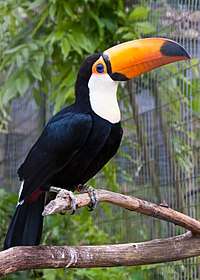
- Woodpeckers and allies (Piciformes)
- The largest species of this diverse order is the toco toucan (Ramphastos toco) of the neotropic forest. Large specimens of this toucan can weigh to 870 g (1.92 lb) and 0.65 m (2.1 ft), at which size the magnificent beak alone could measure about 20 cm (7.9 in).[92]
- The largest woodpecker was, at least until the 20th century, the imperial woodpecker (Campephilus imperialis) of Mexico. This species had a length of up to 0.6 m (2.0 ft) and is generally believed to have gone extinct following habitat destruction and hunting.[93] The closely related ivory-billed woodpecker (Campephilus principalis) of the Southeast United States and Cuba approached similar sizes at up to 0.5 m (1.6 ft), a 0.78 m (2.6 ft) wingspan and a mass of at least 530 g (1.17 lb). Despite possibilities that it has survived in some deep swamp forests in Arkansas or Florida, the ivory-billed is generally considered to have succumbed to the same man-made pressures as its larger cousin.[94] Faring better so far, the great slaty woodpecker (Mulleripicus pulverulentus) of southeast Asia is the largest woodpecker certain to exist, with a weight of up to 500 g (1.1 lb) and a length of up to 0.58 m (1.9 ft).[95]
- Less well-known than the woodpeckers and toucans, the barbets can range up to 273 g (9.6 oz) and 33 cm (13 in) in the great barbet (Megalaima virens).[92]
- The largest jacamar is the great jacamar (Jacamerops aureus). It measures 29.5 to 30 cm (11.61 to 11.81 in) in length and weighs between 63 and 70 g (2.22 and 2.47 oz)[96]
- Grebes (Podicipediformes)
- The largest species of grebe is the South American great grebe (Podiceps major). It can reach a length of 0.8 m (2.6 ft), a 1 m (3.3 ft) wingspan and a weigh of over 2 kg (4.4 lb).[97]
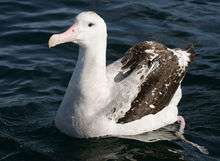
- Tubenoses (Procellariiformes)
- The largest species is wandering albatross (Diomedea exulans) of the sub-Antarctic oceans, which also has the largest wingspan of any living bird. The maximum dimensions in this species are a length of 1.44 m (4.7 ft) and a wingspan of 3.65 m (12.0 ft).[1] Unverified albatross have been reported to 5.3 m (17 ft).[3] Immature wandering albatrosses have weighed as much as 15.9 kg (35 lb) at the time of their first flights, though the maximum reported weight in adults in 12.7 kg (28 lb).[3]
- The southern royal albatross (Diomedea epomophora) lags behind the wandering only slightly in all aspects of size.[83] These great birds can fly for hours on the ocean winds without flapping or needing to land.
- The wandering albatross can travel 6,000 kilometres in 12 days. Their long wingspan help them to travel easily for several hours without flapping.
- Hoatzin (Opisthocomiformes)
- The hoatzin (Opisthocomus hoazin) is a pheasant-sized South American bird, with a total length of 65 cm (26 in) and a maximum weight of 1 kg (2.2 lb), and has a long neck and small head.

- Parrots (Psittaciformes)
- The largest parrot by length and wingspan is the endangered hyacinth macaw (Anodorhynchus hyacinthinus) of the neotropic lowlands, reaching a length of nearly 1.2 m (3.9 ft) long, and a wingspan of 1.4 m (4.6 ft); it weighs only 2 kg (4.4 lb).[98] The heaviest parrot is the nearly extinct kakapo (Strigops habroptila),[99] which is part of the unique New Zealand parrot family. The strange, flightless kakapo may not exceed 0.68 m (2.2 ft) in length, it can however weigh up to 4.1 kg (9.0 lb).[100]
- The largest species in the cockatoo family is the Australasian palm cockatoo (Probosciger aterrimus), at up to 0.6 m (2.0 ft) long and a weight of 1.2 kg (2.6 lb).[101]
- Sandgrouse (Pterocliformes)
- The black-bellied sandgrouse (Pterocles orientalis) is the largest sandgrouse, at a maximum size of 634 g (1.398 lb) and 45 cm (18 in).[102]

- Penguins (Sphenisciformes)
- The largest species is easily the emperor penguin (Aptenodytes forsteri) of the Antarctic, with a maximum height of 1.35 m (4.4 ft) and weight of 46 kg (101 lb).[3] The next largest living species is the king penguin, which grows up to a maximum of 18 kg (40 lb) and 1 m (3.3 ft) tall.[103] At one time, possibly competing with the mammalian pinnipeds, a number of giant penguins existed. The largest is believed to be Anthropornis nordenskjoeldi, having reached a height of 1.8 m (5.9 ft) and a weight of up to 108 kg (238 lb).[104]
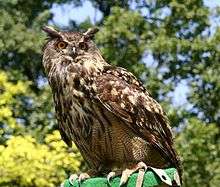
- Owls (Strigiformes)
- The most massive owl is certainly either the Eurasian eagle-owl (Bubo bubo) or the endangered and similarly sized Blakiston's fish owl (Bubo blakistoni) of coastal Russia and Japan. Record-sized specimens of both species have weighed about 4.5 kg (9.9 lb) and measured over 0.75 m (2.5 ft) long.[105] In either species, the wingspan can range up to 2 m (6.6 ft).[106][107] Longer still, but not as massive as the previous species (never more than 1.8 kg (4.0 lb) in weight), a large female great gray owl (Strix nebulosa) from the northern boreal forests can range up to 0.83 m (2.7 ft).[108]
- The largest of the barn or masked owl family is the Tasmanian masked owl (Tyto novaehollandiae castanops), which weighs up to 1.4 kg (3.1 lb) and measures to 0.6 m (2.0 ft).[107] The largest owl known to have existed was Ornimegalonyx oteroi of Cuba, a uniquely cursorial owl. The giant bird was estimated to stand over 1.1 m (3.6 ft) on the ground and to weigh at least 9.05 kg (20.0 lb).[109]

- Ratites (Struthioniformes)
- The largest ratites ostrich (Struthio camelus), from the plains of Africa and Arabia. A large male ostrich can reach a height of 2.8 m (9.2 ft) and weigh over 156 kg (344 lb).[1] A mass of 200 kg (440 lb) has been cited for the ostrich but no wild ostriches of this massive weight have been verified.[2] Eggs laid by the ostrich can weigh 1.4 kg (3.1 lb) and are the largest eggs in the world today. The emu (Dromaius novaehollandiae) of Australia 150 to 190 cm (59–75 in) in height, 1 to 1.3 m (3.3–4.3 ft) at the shoulder. In length measured from the bill to the tail, emus range from 139 to 164 cm (55 to 65 in). The southern cassowary (Casuarius casuarious) from Australia and Papua New Guinea 9.8 to 19 cm (3.9 to 7.5 in).[8] The three-toed feet are thick and powerful, equipped with a lethal dagger-like claw up to 12 cm (4.7 in). The greater rhea (Rhea americana) from South America 20–27 kg (44–60 lb) and often measure 127 to 140 cm (50 to 55 in) long from beak to tail; they usually stand about 1.5 m (4.9 ft). The great spotted kiwi (Apteryx hassti) from New Zealand 9 to 12 cm (3.5–4.7 in), while weight ranges between 1.2 and 2.6 kg (2.6 and 5.7 lb) for males and 1.5 and 3.3 kg (3.3 and 7.3 lb) for females
- The largest bird in the fossil record may be the extinct elephant birds (Aepyornis) of Madagascar, which were related to the ostrich. They exceeded 3 m (9.8 ft) in height and 500 kg (1,100 lb).[3] The last of the elephant birds became extinct about 300 years ago. Of almost exactly the same upper proportions as the largest elephant birds
- The tallest bird ever, however, was the giant moa (Dinornis maximus), part of the moa family of New Zealand that went extinct about 500 years ago. This moa stood up to 3.7 m (12 ft) tall,[1] but weighed about half as much as a large elephant bird or mihirung due to its comparatively slender frame.[3]
- Tinamous (Tinamiformes)
- The largest species of tinamou, a group of chunky, elusive ground-birds from the neotropical forests, is the grey tinamou(Tinamus tao) of western South America. It can reach a weight over 2 kg (4.4 lb) and length of over 55 cm (22 in).[8]
- Trogons (Trogoniformes)
- The resplendent quetzal (Pharomachrus mocinno) of the montane forests of Central America is the largest trogon, though a few other quetzals approach similar sizes. It can weigh more than 226 g (8.0 oz) and, in females and non-breeding or immature males, measure up to 0.4 m (1.3 ft) from the head to the tail. However, when the adult male develops his spectacular tail streamers, his total length is boosted an extra 0.6 m (2.0 ft).[110]
References
- 1 2 3 4 5 6 7 8 9 Largest Birds in The World AllTopTens.com
- 1 2 Avian Medicine: Principles and Application Archived 2009-04-19 at the Wayback Machine.. avianmedicine.net
- 1 2 3 4 5 6 7 8 9 10 11 12 13 14 15 16 Wood, Gerald The Guinness Book of Animal Facts and Feats (1983) ISBN 978-0-85112-235-9
- ↑ Murray, Peter F.; Vickers-Rich, Patricia (2004). Magnificent Mihirungs: The Colossal Flightless Birds of the Australian Dreamtime. Indiana University Press. ISBN 978-0-253-34282-9
- ↑ Alvarenga, H.; Chiappe, L.; Bertelle, S. (2011-05-03), Phorusrhacids: the Terror Birds, in Dyke, G.; Kaiser, G., Living Dinosaurs: The Evolutionary History of Modern Birds, Wiley, pp. 187–208, ISBN 978-0-470-65666-2
- ↑ Vergano, Dan (8 July 2014). "Biggest Flying Seabird Had 21-Foot Wingspan, Scientists Say". National Geopraphic. Retrieved 8 July 2014.
- ↑ Hu, Jane C. (7 July 2014). "The World's Largest Flying Bird". Slate. Retrieved 9 September 2014.
- 1 2 3 4 5 6 7 8 9 10 11 12 13 14 15 16 17 Davies, Stephen, Ratites and Tinamous. Oxford University Press (2002), ISBN 978-0-19-854996-3
- 1 2 3 4 5 6 7 8 9 10 del Hoyo, et al.,Handbook of the Birds of the World. Volume 1: Ostrich to Ducks. Lynx Edicons (1992), ISBN 978-84-87334-10-8
- ↑ Christopher P. Kofron (1999). Attacks to humans and domestic animals by the southern cassowary (Casuarius casuarius johnsonii) in Queensland, Australia. Journal of Zoology, 249, pp 375–381
- 1 2 3 4 5 6 7 8 9 10 CRC Handbook of Avian Body Masses by John B. Dunning Jr. (Editor). CRC Press (1992), ISBN 978-0-8493-4258-5.
- 1 2 Marion, Remi, Penguins: A Worldwide Guide. Sterling Publishing Co. (1999), ISBN 0-8069-4232-0
- ↑ http://www.businessinsider.com/how-big-turkeys-were-then-and-now-2015-11
- ↑ http://extension.illinois.edu/turkey/turkey_facts.cfm
- 1 2 3 4 del Hoyo, J; Elliot, A; Sargatal, J (1996). Handbook of the Birds of the World 3. Barcelona: Lynx Edicions. ISBN 84-87334-20-2.
- ↑ Leopard Seals Group Penguin Slideshow Ppt Presentation. Authorstream.com (2009-03-31)
- ↑ Wood, Gerald (1983). The Guinness Book of Animal Facts and Feats. ISBN 978-0-85112-235-9.
- ↑ American Ornithologists' Union (2010)
- ↑ Remsen et al. (2008)
- ↑ Andean condor videos, photos and facts – Vultur gryphus. ARKive
- 1 2 Christie, David A. & Ferguson-Lee, James, Raptors of the World. Princeton University Press (2006), ISBN 978-0-691-12684-5
- ↑ Himalayan Griffon Vulture. Oiseaux-birds.com
- ↑ Japan's Winter Wildlife Zoom In @ National Geographic Magazine. Ngm.nationalgeographic.com. Retrieved on 2016-12-14.
- ↑ Brathwaite, D. H. (1992). "Notes on the weight, flying ability, habitat, and prey of Haast's Eagle (Harpagornis moorei)" (PDF). Notornis. 39 (4): 239–247. Archived from the original (PDF) on 2006-11-08.
- ↑ Price, Christopher ed., Firefly Encyclopedia of Birds. Firefly Books (2003), ISBN 1-55297-777-3
- ↑ Chantler, Phil, Swifts: A Guide to the Swifts and Treeswifts of the World. Pica Press (1993), ISBN 978-0-300-07936-4
- ↑ Fjeldsa, Jon; Krabbe, Niels (1990). Birds of the High Andes. Zoological Museum, University of Copenhagen, Denmark. p. 876.
- ↑ Ridgely, Robert S., The Birds of Ecuador, Vol. 2: Field Guide. Cornell University Press (2001), ISBN 978-0-8014-8721-7
- ↑ Cleere, Nigel, Nightjars: A Guide to the Nightjars, Nighthawks, and Their Relatives. Yale University Press (1998), ISBN 978-0-300-07457-4
- ↑ Great Potoo- Truths & Legends. En.caiman.com.br (2010-12-06).
- ↑ Oilbird Card. Oiseaux-birds.com.
- ↑ Howell, Steven N.G. & Dunn, Jon, Peterson Reference Guides: Gulls of the Americas. Houghton Mifflin Harcourt (2007), ISBN 0-618-72641-1.
- ↑ Brazil, Mark, Birds of East Asia. Christopher Helm Ornithology (2009), ISBN 978-0-7136-7040-0
- ↑ Far Eastern Curlew. birdfellow.com
- ↑ Masked Lapwing Card. Oiseaux-birds.com.
- ↑ Caspian Tern (Sterna caspia) – Birds in Backyards Fact sheet. Birdsinbackyards.net (2005-08-21) Archived November 26, 2011, at the Wayback Machine.
- ↑ forsteri. msue.msu.edu
- ↑ Thick-billed Murre Archived 2013-11-10 at the Wayback Machine.. Nhptv.org.
- ↑ Fuller, Errol, Great Auk. Harry N. Abrams (1999), ISBN 978-0-8109-6391-7.
- ↑ Smith, N. 2015. Evolution of body mass in the Pan-Alcidae (Aves, Charadriiformes): the effects of combining neontological and paleontological data. Paleobiology. doi: 10.1017/pab.2015.24
- ↑ Saddle-billed Stork card. Oiseaux-birds.com.
- ↑ Hancock & Kushan, Storks, Ibises and Spoonbills of the World. Princeton University Press (1992), ISBN 978-0-12-322730-0
- ↑ The Bhutan Observer The Independent Voice (August 29th 2008)
- ↑ Miller, Loye H. (1909): Teratornis, a new avian genus from Rancho La Brea. University of California Publications, Bulletin of the Department of Geology 5: 305–317.
- ↑ Speckled – Welcome to the wonderful world of Mousebirds. Mousebirds.com
- ↑ Gibbs, David, Pigeons and Doves. A&C Black (2001), ISBN 978-1-873403-60-0
- ↑ NFC: Passenger Pigeon in my non fish conservation posts :0. Fins.actwin.com. Retrieved on 2011-12-18.
- ↑ Vermeij, Geerat J. (2004). Nature: An Economic History. Princeton University Press, ISBN 0691115273
- ↑ Angst, D.; Buffetaut, E.; Abourachid, A. (2011). "The end of the fat dodo? A new mass estimate for Raphus cucullatus". Naturwissenschaften. 98 (3): 233–236. Bibcode:2011NW.....98..233A. doi:10.1007/s00114-010-0759-7. PMID 21240603.
- ↑ Reunion Solitaire. Internationaldovesociety.com
- ↑ What were the Dodo and Solitaire like?. DodoSite
- ↑ Southern Ground-Hornbill – Bucorvus cafer. Oiseaux.net (2009-10-25) Archived November 10, 2013, at the Wayback Machine.
- ↑ Alan Kemp, The Hornbills: Bucerotiformes. Oxford University Press (1995), ISBN 978-0-19-857729-4
- ↑ Helmeted hornbill videos, photos and facts - Rhinoplax vigil. ARKive
- ↑ Hornbill Profile. Sandiegozoo.org.
- ↑ Giant Kingfisher. Oiseaux-birds.com
- ↑ Knowles, Leslie, Kingfishers of the World. Times Edn (1995), ISBN 978-981-204-470-9
- ↑ Payne, Robert B.,The Cuckoos. Oxford University Press (2005), ISBN 978-0-19-850213-5
- ↑ Channel-billed Cuckoo. Naturalhistory.org.au (2011-02-10)
- ↑ Separate Accipitriformes from Falconiformes Archived 2010-06-28 at the Wayback Machine.. Museum.lsu.edu
- ↑ National Wild Turkey Federation. Nwtf.org
- ↑ San Diego Zoo's Animal Bytes: Peafowl. Sandiegozoo.org
- ↑ Jones, Darryl & Göth, Ann, Mound-Builders (Australian Natural History Series). CSIRO Publishing (2009), ISBN 978-0-643-09345-4
- ↑ Gavia immer: Information. Animaldiversity.ummz.umich.edu (2004-10-06) Archived November 10, 2013, at the Wayback Machine.
- ↑ The Great bustard returns: Tetrapod Zoology Archived 2011-11-23 at the Wayback Machine.. Scienceblogs.com (April 2010)
- ↑ Entity Display : Ardeotis kori. Ecoport.org (2005-01-17)
- ↑ Sarus Crane. gruitag.org
- ↑ The Wildlife Year, The Reader's Digest Association, (1991). ISBN 0-276-42012-8
- ↑ Red-Crowned Crane Fact Sheet. Nationalzoo.si.edu Archived October 11, 2012, at the Wayback Machine.
- ↑ Sterling, et al., Vietnam: A Natural History. Yale University Press (2006), ISBN 978-0-300-10608-4
- ↑ Taylor, Barry, Rails: A Guide to the Rails, Crakes, Gallinules and Coots of the World. Yale University Press (1998), ISBN 978-0-300-07758-2
- ↑ Common Raven. Oiseaux-birds.com
- ↑ Bambaradeniya, et al., The Illustrated Atlas of Wildlife. University of California Press (2009), ISBN 978-0-520-25785-6
- ↑ FieldGuides: Species Detail. eNature Archived November 10, 2013, at the Wayback Machine.
- ↑ Blue Whistling-Thrush. Oiseaux-birds.com
- ↑ Handbook of the Birds of the World, Volume 11: Old World Flycatcher's to the Old World Warblers. Lynx Edicions (2006), ISBN 978-84-96553-06-4
- ↑ Yellow-breasted Chat, Life History, All About Birds – Cornell Lab of Ornithology. Allaboutbirds.org
- ↑ Tennessee Watchable Wildlife. Yellow-breasted Chat. Tnwatchablewildlife.org
- ↑ ZootierlisteHomepage. Zootierliste.de
- ↑ Clement, Peter, Finches & Sparrows. Princeton University Press (1999), ISBN 978-0-691-04878-9
- ↑ Byers, Clive, Sparrows and Buntings: A Guide to the sparrows and Buntings of North America and the World. Houghton Mifflin (1997), ASIN B000ZFNLXS
- ↑ Hilty, Steven L., Birds of Venezuela. Princeton University Press (2003), ISBN 978-0-691-09250-8
- 1 2 Harrison, Peter, Seabirds: An Identification Guide. Houghton Mifflin Harcourt (1991), ISBN 978-0-395-60291-1
- ↑ Galapagos Wildlife, Flightless Cormorant. Ecostravel.com
- ↑ Philip H.R. Stepney. . The Canadian Encyclopedia
- ↑ Magnificent Frigatebird, Life History, All About Birds – Cornell Lab of Ornithology. Allaboutbirds.org
- ↑ Procelariiform Encyclopædia Britannica Online
- ↑ 10 Giant Prehistoric Creatures – A List of History's Strangest Prehistoric Giants. Dinosaurs.about.com (2011-06-16)
- ↑ Mayr, G.; Rubilar-Rogers, D. (2010). "Osteology of a new giant bony-toothed bird from the Miocene of Chile, with a revision of the taxonomy of Neogene Pelagornithidae" (PDF). Journal of Vertebrate Paleontology. 30 (5): 1313. doi:10.1080/02724634.2010.501465.
- ↑ All About Flamingos. tourduvalat.org Archived July 28, 2013, at the Wayback Machine.
- ↑ Flamingos. Seaworld.org
- 1 2 Short, Lester & Horne, Jennifer, Toucans, Barbets and Honeyguides (Bird Families of the World). Oxford University Press (2002), ISBN 978-0-19-854666-5
- ↑ Imperial Woodpecker (Campephilus imperialis) – BirdLife species factsheet. Birdlife.org
- ↑ Welcome — Ivory-billed Woodpecker. Birds.cornell.edu
- ↑ Winkler, et al., Woodpeckers: An Identification Guide to the Woodpeckers of the World. Houghton Mifflin (1995), ISBN 978-0-395-72043-1
- ↑ Jacamaraçu; WikiAves.
- ↑ del Hoyo, Elliott & Sargatal. Handbook of Birds of the World, Volume 1 Ostrich to Ducks. ISBN 84-87334-10-5
- ↑ Exotic Birds – Scarlet Macaw, Hyacinth Macaw, Gold Blue Macaw and Green Wing Macaw Wholesaler & Retailer. Sarapetstudios.com (2011-10-05) Archived 2012-06-26 at the Wayback Machine.
- ↑ Walley, H. D.; Ruback, P. A. (2006). "Ornithological Literature". The Wilson Journal of Ornithology. 118 (4): 581. doi:10.1676/1559-4491(2006)118[581:OL]2.0.CO;2.
- ↑ Elliott, Greaeme P (2006). A simulation of the future of kakapo. Society 53(1): 164-172
- ↑ Forshaw, Joseph, Parrots of the World. TFH Publications (1978), ISBN 978-0-87666-959-4
- ↑ del Hoyo, Elliott & Sargatal. Handbook of Birds of the World, Volume 4: Sandgrouse to Cuckoos. ISBN 84-87334-22-9
- ↑ Marie-Anne Thil and René Groscolas (2002). "Field Immobilization of King Penguins with Tiletamine-Zolazepam (Uso de tiletamine-zolazepam para inmobilizar Aptenodytes patagonicus en el campo)". Journal of Field Ornithology. 73 (3): 308–317. JSTOR 4131109.
- ↑ Body Mass of Extinct Penguins. app.pan.pl
- ↑ Take A Peek At Boo, The Eagle Owl – QUILLCARDS BLOG. Quillcards.com (2009-09-23)
- ↑ Eagle Owl. Pauldfrost.co.uk.
- 1 2 A Guide to the Owls of the World by Konig, Weick & Becking. Yale University Press (1999), ISBN 0300142277
- ↑ Grey Owl (Strix nebulosa). OwlPages.
- ↑ Arredondo, Oscar (1976) translated Olson, Storrs L. The Great Predatory Birds of the Pleistocene of Cuba pp. 169–187 in "Smithsonian Contributions to Paleobiology number 27; Collected Papers in Avian Paleontology Honoring the 90th Birthday of Alexander Wetmore"
- ↑ Johnsgard, Paul A., Trogons and Quetzals of the World. Smithsonian Institution Scholarly Press (2000), ISBN 978-1-56098-388-0